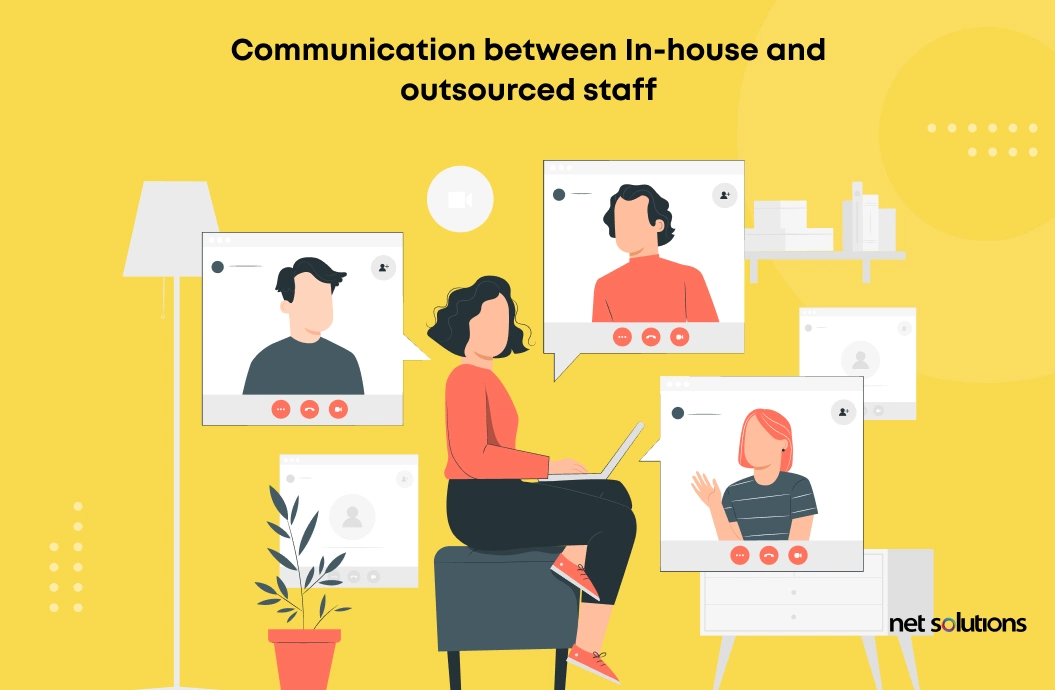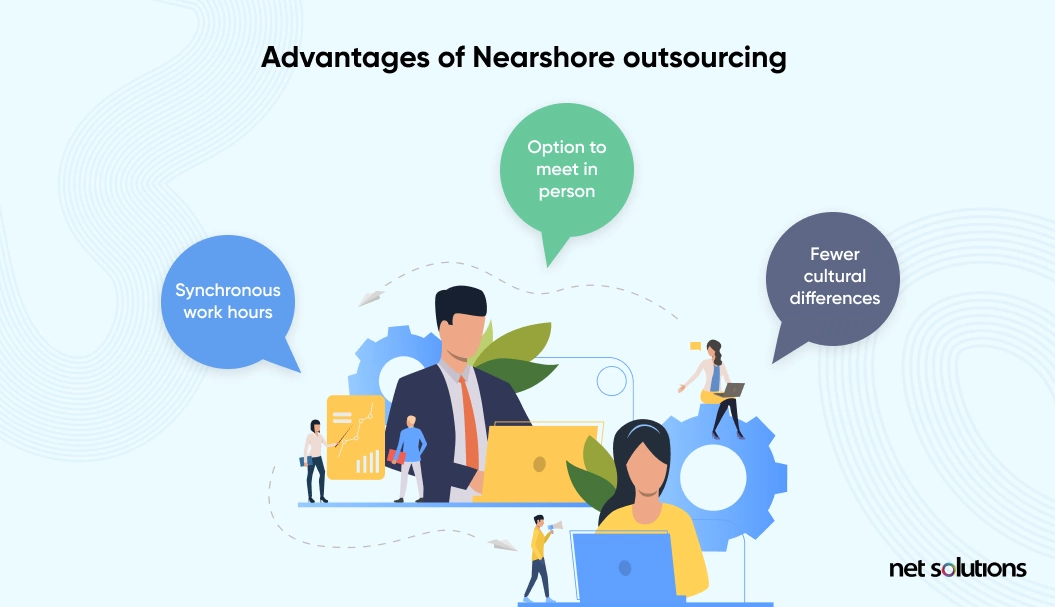Summary: Nearshoring is one of three main options for outsourcing software development (along with onshoring and offshoring). If you’re thinking of nearshoring any portion of your software development or QA Testing, this post provides clear steps on how to strategically build a nearshore software development team.
A growing number of companies are outsourcing large components of their software development these days, and one study anticipates a 70% growth rate for outsourcing in the coming years. Companies that choose the right software development outsourcing partners can reduce costs, boost efficiency, and enhance their ability to compete in competitive markets.
If you’re considering outsourcing part or all of your software development, design, or QA testing, your first decision is whether to choose an onshore, nearshore, or offshore partner. There are advantages and disadvantages to each strategy, and even though Net Solutions is an offshore partner for many North American and European companies, we want you to make the best decision for your business.

We respect your privacy. Your information is safe.
If you’re looking to outsource work to a nearshore software development firm, the following 7 steps will help you build an effective team that produces high-quality software.
What Is Nearshore Software Development?
Nearshore software development is a software development outsourcing strategy that works with development partners in nearby countries. For example, a U.S. company might decide to outsource its software development to a Canadian firm, or a German company might outsource to a Polish firm. Nearshoring can reduce costs compared to in-house development, and growing companies can use it to help handle an overflow of work.

There are many different types of outsourcing, and we’ve put together a comprehensive review that outlines the differences between offshoring, nearshoring, and onshoring (with helpful tips on how to decide which strategy works best for you). Also, feel free to review our broad overview of software development outsourcing, which covers the benefits of,risks, what to look for in an outsourcing partner, and how to measure Key Performance Indicators (KPIs) when it comes time to evaluate your outsourcing partner.
7 Steps to Build a Nearshore Development Team
Step 1. Begin a Comprehensive Search for Quality Candidates

Choosing the right nearshore partner (or any outsourcing partner for that matter) is a big decision for a variety of reasons. First, you’re entrusting them with the source code to your software, so at the very least you need to make sure you’re dealing with someone trustworthy and thoroughly vetted.
Your screening process should begin with websites like Clutch, GoodFirms, Agency Spotter, Crowd Reviews, or G2 Crowd. These sites provide reviews for agencies from past clients so you can find an honest, competent agency.
It’s also important to cross-reference sites on different reviews because a nearshoring company might have an excellent set of reviews on one site but have less impressive reviews on another. You can expect some variation, but a vast difference in scores from one site to the next should raise some concerns.
Lastly, be sure to visit each potential partner’s website to see how they present themselves to the world. It will also give you a chance to learn more about their work.
Step 2: Review Each Potential Partner’s Portfolio
Every legitimate nearshoring partner should have a thorough portfolio that outlines work they’ve done in a variety of fields. Ideally, they will have experience in a similar industry to yours. That doesn’t mean you need to see work done in precisely the same field, but if you’re an e-commerce company, you’ll want to see samples of other e-commerce platforms, websites, or apps.
Step 3: Interview Ideal Candidates and Find the Best Fit

Once you’ve reached out to potential nearshoring partners, don’t be afraid to ask tough questions to verify both their big-picture understanding and their technical expertise. If you’re conducting business in English or any other language that isn’t your prospective partners’ native tongue, make sure they’re operating at a high level of fluency. And don’t just chat with account executives who are polished and must be fluent to perform their jobs! Speak with the people you and your staff will be interacting with on a regular basis, whether those are project managers or the developers themselves.
Finally—and this is key—dig deep and explore your potential partner’s approach to software development. What are their thoughts on choosing an MVP approach to product creation? Are they fans of Agile SCRUM or some other methodology? How do they plan to approach your project?
Make sure their answers indicate that they think strategically about your product and your vision. You don’t want to work with a team of order-takers who won’t offer input and help your products evolve.
Step 4: Create Agreements Before Building the Team

Paperwork is never fun, but poorly worded contracts can impact your business. Hash out all the details related to payment, access to sensitive data, and any other legal details. The following agreements should be thoroughly reviewed by your legal team before signing should you decide to use them.
- Master Services Agreements: When two parties enter a business relationship with the intention of working together over a long period of time, a Master Services Agreement (MSA) is a valuable asset. It sets the terms that will govern future projects, including things like confidentiality, intellectual property rights, payment terms, limitations of liability, and other important ideas. Simply put, an MSA means you don’t have to start from scratch to define the terms of each engagement. If you need to set specific terms for individual projects, that’s where Service Level Agreements come in.
- Service Level Agreements: Service Level Agreements (SLAs) outline specific parameters for a given project or set of projects.
- Non-Disclosure Agreements: Non-Disclosure Agreements (NDAs) safeguard your corporate secrets, in case your nearshore partner ends up working with the competition at some point.
Putting these things in place before building the team will ensure you’re on the same page as your prospective partner. If you’ve got serious disagreements, you’ll want to figure that out before dedicating more resources to the project or sharing sensitive information.
Step 5: Clearly Identify Any Project Planning Details

It’s important that any nearshoring partner understands your product vision, and that means sharing your plans for developing your products in the quarters ahead. If you have a product roadmap, it’s important to share it with your new partners—even if you have to present a modified roadmap to safeguard certain elements of your strategy.
If you’ve got an in-house team, it typically makes sense to have your nearshore team adapt to your software development framework. Make sure the key people on your in-house team and your nearshore team are comfortable connecting with each other.
Step 6: Foster Communication Between In-house and Outsourced Staff

Solid communication between your in-house employees and your outsourcing partners is ideal because excellent software begins with proper planning and nuanced communication. If there’s a rift between onsite and offsite staff, developers might forge ahead and work on something without consulting each other. That often results in problems and costly rework.
One way to support communication is to have everyone meet in person every once in a while if your budget can accommodate it. Flying your nearshore team to your location, giving them the opportunity to meet your staff and tour your facilities, provides a more intimate understanding of what you do and what your work is designed to accomplish. At the very least, regular video meetings help facilitate deeper connections.
Step 7: Build Your Team Strategically

Work closely with your outsourcing partner to determine how to build the most effective nearshore team—one that is both cost-effective and efficient. Have a frank discussion about tech stacks, skill sets, team sizes, and delivery timelines.
Be sure to assign a QA engineer to the team for proper monitoring. A QA engineer designs all testing to help the QA team identify software problems with software prior to any product launch or before launching any new features. The QA engineer will also develop and execute new tests and report the results back to the engineering team. Since producing software with minimal bugs is key to your success, the QA engineer’s role is critical.
As you continue to work with your nearshore partner, don’t be afraid to explore new arrangements in terms of team structure. Over time, you and your nearshore partners should become a well-oiled machine, producing quality software just as any 100% in-house team would produce while working side-by-side.
Advantages of Nearshore Software Development Outsourcing

Software development outsourcing in general has a number of advantages, whether you do it to a country nearby or to one on the opposite side of the world.
Choosing the right partner can deliver cost savings, increased output, and greater efficiency, although offshoring often represents greater savings. It can also represent higher output and efficiency since your offshore team can work while your in-house team sleeps. For example, you can hire a team on the opposite side of the globe to perform QA testing overnight, and the next morning your in-house developers can review the results and push out more code. That’s exactly what Net Solutions did for Kitco, a precious metals trading platform.
So, what are the advantages of nearshoring compared to offshoring?
1. Synchronous Work Hours
Unless your offshore partner is willing to sync up with your local work hours, it may be difficult to have meetings and communicate. Upon request, we can sync a team’s work hours with our clients’ work hours here at Net Solutions, but not everyone is willing to do that.
2. Option to Meet in Person
If you like to meet in person from time to time and it’s worth the expense, that’s possible with nearshore development partners.
3. Fewer Cultural Differences (Sometimes!)
At times, there are fewer cultural differences when you choose a nearshore partner, assuming they speak the same language as your in-house staff. An American company that outsources to Canada, or a Chilean company that outsources to Argentina, will have minimal communication gaps. On the other hand, a German company might have an easier time outsourcing to India than to Belarus, simply because there’s a high level of English fluency in both Germany and India.
The bottom line? Whether you go nearshore or offshore, have plenty of conversations with your software development outsourcing partner to ensure there is little-to-no language barrier or cultural disconnect.
Intelligent Software Development Outsourcing
Whether you choose to go with an onshore team, a nearshore partner, or an offshore development company, it’s important to have all the facts. We’ve written extensively on the topic here at Net Solutions, and the following guides will help you make the right decision:
- Nearshore vs. Offshore Software Development: How to Decide?
- What is Outsourcing? The Ultimate Outsourcing Checklist
If you’re considering offshore outsourcing, talk to one of our experts at Net Solutions. Over the past two decades, we’ve partnered with household names like Microsoft, PayPal, IMG, and the Harvard Business Review—along with countless startups.
Frequently Asked Questions
There are many examples of large companies that use nearshoring, although much of the time nearshoring exists outside of the tech space since software development outsourcing isn’t bound by physical constraints. Perhaps the most well-known example of nearshoring was Toyota’s decision to nearshore auto manufacturing in the Philippines in the 90s. Many other manufacturers have since followed their lead.
Some common businesses (and tasks within certain businesses) are more ideally suited to nearshoring, such as:
- Software Development Outsourcing Services
- Back-End Development Services
- Front End Development Company
- SaaS Application Development Services
Of course, any of these tasks can also be offshored to competent companies overseas, since they don’t require the production of any tangible products.
Nearshore outsourcing refers to partnering with businesses in countries nearby, while offshore partnerships can exist on the opposite side of the globe.
Nearshore outsourcing is sometimes less advantageous than offshore outsourcing because it can be more expensive. Also, offshore teams can work while your in-house team sleeps. However, if your in-house team would benefit from working the same hours as your outsourced staff, then nearshoring may be a better choice.



